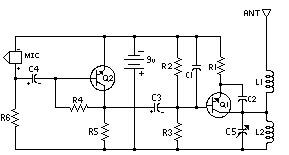| Parts | |||
| Part | Total Qty. | Description | Substitutions |
| C1 | 1 | 0.001uf Disc Capacitor | |
| C2 | 1 | 5.6pf Disc Capacitor | |
| C3,C4 | 2 | 10uf Electrolytic Capacitor | |
| C5 | 1 | 3-18pf Adjustable Cap | |
| R1 | 1 | 270 Ohm 1/8W Resistor | 270 Ohm 1/4W Resistor |
| R2,R5,R6 | 3 | 4.7k 1/8W Resistor | 4.7K 1/4W Resistor |
| R3 | 1 | 10k 1/8W Resistor | 10K 1/4W Resistor |
| R4 | 1 | 100k 1/8W Resistor | 100K 1/4W Resistor |
| Q1, Q2 | 2 | 2N2222A NPN Transistor | 2N3904, NTE123A |
| L1, L2 | 2 | 5 Turn Air Core Coil | |
| MIC | 1 | Electret Microphone | |
| MISC | 1 | 9V Battery Snap, PC Board, Wire For Antenna | |
- L1 and L2 are 5 turns of 28 AWG enamel coated magnet wire wound with a inside diameter of about 4mm. The inside of a ballpoint pen works well (the plastic tube that holds the ink). Remove the form after winding then install the coil on the circuit board, being careful not to bend it.
- C5 is used for tuning. This transmitter operates on the normal broadcast frequencies (88-108MHz).
- Q1 and Q2 can also be 2N3904 or something similar.
- You can use 1/4 W resistors mounted vertically instead of 1/8 W resistors.
- You may want to bypass the battery with a .01uf capacitor.
- An antenna may not be required for operation.





